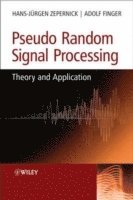
- Format
- Inbunden (Hardback)
- Språk
- Engelska
- Antal sidor
- 436
- Utgivningsdatum
- 2005-09-01
- Upplaga
- 1
- Förlag
- John Wiley & Sons Inc
- Medarbetare
- Finger, Adolf
- Illustrationer
- Illustrations
- Dimensioner
- 252 x 172 x 30 mm
- Vikt
- Antal komponenter
- 1
- ISBN
- 9780470866573
- 980 g
Pseudo Random Signal Processing
Theory and Application
Kundrecensioner
Fler böcker av författarna
-
Pseudorandom-Signalverarbeitung
Adolf Finger
Övrig information
Zepernick, Hans-Jurgen is affiliated to Department Of Creative Technologies, Blekinge Institute of Technology, where Zepernick, Hans-Jurgen is currently working as Professor. Zepernick, Hans-Jurgen has numerous publications within the specialty and published in reputed national and international peer-reviewed journals. Zepernick, Hans-Jurgen is actively associated with different national and international societies and academies. Zepernick, Hans-Jurgen gain recognition among the honourable subject experts with the contributions made. Dr. Zepernick, Hans-Jurgen is been appreciated by several reputed awards and funding support. Dr. Zepernick, Hans-Jurgen major research interest is in studies related to control engineering & cybernetics,Decision Support System. Adolf Finger received the Dipl.-Ing. degree (MSc) from Dresden University of Technology, (TUD), Germany, and the Dr.-Ing. degree (PhD) with summa cum laude from the same University, both in electrical engineering. He holds the positions of Professor in Communications Theory, Managing Director of the Communications Laboratory and until 2006 dean of the Department of Electrical Engineering and Information Technology at TUD.Adolf Finger is author and co-author of some 60 technical papers in the areas of communications systems, coding techniques, wireless communications, signal and sequence design. He is author of two textbooks: Digitale Signalstrukturen, Verlag Technik Berlin/R. Oldenbourg Munchen, Wien (1985) Pseudorandom Signalverarbeitung, Teubner Verlag Stuttgart (1997) and co-author (with H.-J. Zepernick) of the book: Pseudo Random Signal Processing, Wiley 2005 and 2007 (China- Edition).
Innehållsförteckning
Preface. List of abbreviations. List of common symbols. 1. Introduction. 1.1 Prologue. 1.2 Elements of pseudo random signal processing. 1.3 Outline of the book. 2. Characterization of signals and sequences. 2.1 Classification of signals and sequences. 2.2 Transformations of signals and sequences. 2.3 Correlation measures. 2.4 Power spectral density. 2.5 Pseudo random signals and sequences. 3. Mathematical foundations. 3.1 Algebraic structures. 3.2 Polynomials over finite fields. 4. Binary pseudo random sequences. 4.1 Classification. 4.2 Maximal-length sequences. 4.3 Binary sequences with good autocorrelation. 4.4 Binary sequences with special cross-correlation. 5. Nonbinary pseudo random sequences. 5.1 Classification. 5.2 Interference-free window sequences. 5.3 Complex-valued sequences. 5.4 Polyphase sequences with special correlations. 6. Generating pseudo random signals. 6.1 Linear autonomous automata. 6.2 Generating maximal-length sequences. 6.3 Transformations of maximal-length sequences. 6.4 Combinations of maximal-length sequences. 6.5 Pseudo random signal processing with microprocessors and memory circuits. 7. Applications of pseudo random signal processing. 7.1 Spread spectrum communications. 7.2 Ranging and navigation systems. 7.3 Scrambling. 7.4 Automatic testing and system verification. 7.5 Cryptology. 7.6 Other applications. Bibliography. Index.
Du kanske gillar
-
Orbital
Samantha Harvey
Häftad -
Empire of AI
Karen Hao
Inbunden
